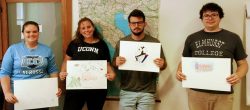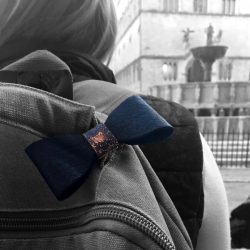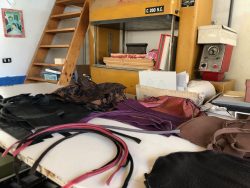
An article by Rocco Catrone— adjunct faculty and Behavior Analysis practitioner at Elmhurst College, visiting professor and alumnus of the Umbra Institute.
It has been 7 years since my life changed in ways I never thought possible.
Some days, it feels like a lifetime ago but in even more ways, it was as if it only happened yesterday. In the Fall Semester of 2011, I studied abroad at the Umbra Institute in Perugia. A fairy-tale dream of a medieval town in Central Italy – a place you most likely never heard of beyond those delicious Italian chocolate kisses called Baci. Little did I know that the stone walls, warm welcome from the community, Italian lifestyle, and excellent education would leave me wanting to come back.
So I did.
This summer, I am teaching a course called PSYC 260: Radical Communication which looks at how language affects the way humans behave in politics, education, and religion. Each week, we learn our topics and then apply this to the community through observations in schools, participating in clinics, or simply being integrated in the town we call home for this time.
During one of my favorite observations, my students and a local high school class were able to talk about and compare different idioms used in each of their cultures. The differences between “break and leg” and “into the mouth of the wolf” having the same functional meaning which is not immediately clear just looking at the words. My students and the high schoolers enjoyed this activity so much that we were asked to come back and further look at cultural differences through interviews to learn more about the differences and similarities in Italian and USA culture. This information was learned first-hand and not in some textbook.
The nuances of a culture are more apparent when you are directly living there, surrounded by others who did not grow up in your own cultural context. This is something, which was taught to me during my time here, that I try to bring to my students. We learn in class lectures and class activities how to be more culturally competent – How are choices made? How does different learning histories affect this? How does language factor in all of this?
Perugia is a perfect classroom to learn these topics as it is unlike the more popular Naples, Florence, Milan, or Rome. You live here and are a part of the community. We live in apartments in buildings with other local Italians – not dorms. We learn Italian by ordering food at the grocery store and connecting with the local merchants in the giant open-air markets. Evening walks with friends down the main drag while enjoying gelato. All of this without being glued to a phone or computer.
Perugia has its hold on me and a piece of my heart will always be here. The Umbra staff have been instrumental in my coming back and I thank them every day for giving me this opportunity to do so. I hope to return next year and every year after that to share this wonderful place with my students.
Be sure to check out my students blogs posts during their experiences here tying what they learned in class to the observations!
Click here to learn more about Umbra’s Multicultural Psychology Program and opportunities to study similar topics during a semester abroad.


 About every other week, Umbra hosts an event called Tandem, which allows students from Perugia to meet with Umbra students in a language exchange opportunity. The Italian students get a chance to practice their English, while we get to speak Italian. It is a very open and comfortable setting, making it easier to not be afraid of making mistakes and to speak freely. We help each other out and even make some pretty good local friends. One friend in which I met offered to take us to one of the local Perugia soccer matches for Perugia’s Serie B squad. It was really fun, as he took us to the supporter’s section so we could get the real experience of being a fan of AC Perugia. It also gave us a chance to continue practicing Italian and learn the soccer chants for the team.
About every other week, Umbra hosts an event called Tandem, which allows students from Perugia to meet with Umbra students in a language exchange opportunity. The Italian students get a chance to practice their English, while we get to speak Italian. It is a very open and comfortable setting, making it easier to not be afraid of making mistakes and to speak freely. We help each other out and even make some pretty good local friends. One friend in which I met offered to take us to one of the local Perugia soccer matches for Perugia’s Serie B squad. It was really fun, as he took us to the supporter’s section so we could get the real experience of being a fan of AC Perugia. It also gave us a chance to continue practicing Italian and learn the soccer chants for the team. Coming into the program, it was expected that we would each create a doll in the six weeks with help from the coordinators. The women at the Unicef Headquarters spoke only Italian, but we could understand their devotion to the organization and the gratification that it brought them. It was also enriching to be connected with a different generation and language.
Coming into the program, it was expected that we would each create a doll in the six weeks with help from the coordinators. The women at the Unicef Headquarters spoke only Italian, but we could understand their devotion to the organization and the gratification that it brought them. It was also enriching to be connected with a different generation and language. On March 9th and 10th, Dr. Elisa Ascione, Coordinator of the Umbra Institute’s Food & Sustainability Program (FSSP), facilitated the Food, Heritage & Community Conference in Prague, Czech Republic. The goal of the conference, sponsored by
On March 9th and 10th, Dr. Elisa Ascione, Coordinator of the Umbra Institute’s Food & Sustainability Program (FSSP), facilitated the Food, Heritage & Community Conference in Prague, Czech Republic. The goal of the conference, sponsored by  Among the presenters was Dr. Peter Naccarato, Interim Program Director at the Umbra Institute and Professor of English & World Literatures at Marymount Manhattan College. Dr. Naccarato, presented his paper, “Brooklyn Goes Global: When Local Culinary Culture Becomes a Global Phenomenon.” He explained that this paper was part of a chapter that he and his co-author, Dr. Katie LeBesco, are writing for a forthcoming book on “Global Brooklyn.” The goal of the book is to understand how and why a set of objects, designs, interior decorating, architecture and other practices have traveled from cafes and restaurants in Brooklyn, New York to cities across the world. For their chapter, Dr. Naccarato and Dr. LeBesco are exploring the differences between the actual New York City borough of Brooklyn and the imagined space called “Global Brooklyn.” They consider Brooklyn’s place in the cultural imaginary: Who does and who doesn’t inhabit Global Brooklyn? How do Global Brooklyn’s aesthetic and culinary practices interface with working class and immigrant people who have been displaced within the borough and who have distinctly different eating and drinking practices? What does this mean for the imagined version of Brooklyn that is translated around the world, and how does it impact those who inhabit the “real” physical place?
Among the presenters was Dr. Peter Naccarato, Interim Program Director at the Umbra Institute and Professor of English & World Literatures at Marymount Manhattan College. Dr. Naccarato, presented his paper, “Brooklyn Goes Global: When Local Culinary Culture Becomes a Global Phenomenon.” He explained that this paper was part of a chapter that he and his co-author, Dr. Katie LeBesco, are writing for a forthcoming book on “Global Brooklyn.” The goal of the book is to understand how and why a set of objects, designs, interior decorating, architecture and other practices have traveled from cafes and restaurants in Brooklyn, New York to cities across the world. For their chapter, Dr. Naccarato and Dr. LeBesco are exploring the differences between the actual New York City borough of Brooklyn and the imagined space called “Global Brooklyn.” They consider Brooklyn’s place in the cultural imaginary: Who does and who doesn’t inhabit Global Brooklyn? How do Global Brooklyn’s aesthetic and culinary practices interface with working class and immigrant people who have been displaced within the borough and who have distinctly different eating and drinking practices? What does this mean for the imagined version of Brooklyn that is translated around the world, and how does it impact those who inhabit the “real” physical place? Umbra Program:
Umbra Program:  Photo credit: Callie Cinque
Photo credit: Callie Cinque